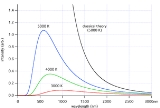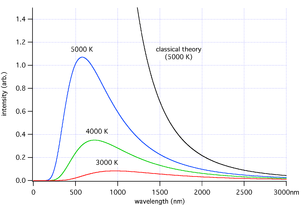
Modern physics
Encyclopedia
The term modern physics refers to the post-Newtonian conception
of physics
. The term implies that classical descriptions
of phenomena are lacking, and that an accurate, "modern", description of reality requires theories to incorporate elements of quantum mechanics
or Einsteinian relativity
, or both. In general, the term is used to refer to any branch of physics either developed in the early 20th century and onwards, or branches greatly influenced by early 20th century physics.
Modern physics often involves extreme conditions; quantum effects usually involve distances comparable to atom
s (roughly 10−9 m
), while relativistic effects usually involve velocities comparable to the speed of light
(roughly 108 m/s). Small velocities and large distances is usually the realm of classical mechanics.
is modern. However, since roughly 1890, new discoveries have caused significant paradigm shift
s; the advent of quantum mechanics
(QM), and of Einsteinian relativity (ER). Physics that incorporates elements of either QM or ER (or both) is said to be modern physics. It is in this latter sense that the term is generally used.
Modern physics is often encountered when dealing with extreme conditions. Quantum mechanical effects tend to appear when dealing with "lows" (low temperatures, small distances), while relativistic effects tend to appear when dealing with "highs" (high velocities, large distances), the "middles" being classical behaviour. For example, when analysing the behaviour of a gas
at room temperature
, most phenomena will involve the (classical) Maxwell–Boltzmann distribution. However near absolute zero
, the Maxwell–Boltzmann distribution fails to account for the observed behaviour of the gas, and the (modern) Fermi–Dirac or Bose–Einstein distributions have to be used instead.
Very often, it is possible to find – or "retrieve" – the classical behaviour from the modern description by analysing the modern description at low speeds and large distances (by taking a limit
, or by making an approximation
). When doing so, the result is called the classical limit
.

Classical physics
What "classical physics" refers to depends on the context. When discussing special relativity, it refers to the Newtonian physics which preceded relativity, i.e. the branches of physics based on principles developed before the rise of relativity and quantum mechanics...
of physics
Physics
Physics is a natural science that involves the study of matter and its motion through spacetime, along with related concepts such as energy and force. More broadly, it is the general analysis of nature, conducted in order to understand how the universe behaves.Physics is one of the oldest academic...
. The term implies that classical descriptions
Classical physics
What "classical physics" refers to depends on the context. When discussing special relativity, it refers to the Newtonian physics which preceded relativity, i.e. the branches of physics based on principles developed before the rise of relativity and quantum mechanics...
of phenomena are lacking, and that an accurate, "modern", description of reality requires theories to incorporate elements of quantum mechanics
Quantum mechanics
Quantum mechanics, also known as quantum physics or quantum theory, is a branch of physics providing a mathematical description of much of the dual particle-like and wave-like behavior and interactions of energy and matter. It departs from classical mechanics primarily at the atomic and subatomic...
or Einsteinian relativity
Theory of relativity
The theory of relativity, or simply relativity, encompasses two theories of Albert Einstein: special relativity and general relativity. However, the word relativity is sometimes used in reference to Galilean invariance....
, or both. In general, the term is used to refer to any branch of physics either developed in the early 20th century and onwards, or branches greatly influenced by early 20th century physics.
Modern physics often involves extreme conditions; quantum effects usually involve distances comparable to atom
Atom
The atom is a basic unit of matter that consists of a dense central nucleus surrounded by a cloud of negatively charged electrons. The atomic nucleus contains a mix of positively charged protons and electrically neutral neutrons...
s (roughly 10−9 m
1 E-9 m
To help compare different orders of magnitudes this page lists lengths between 10−9 metres and 10−8 metres .Distances shorter than 1 nanometre*1 nm = 1 nanometre = 1000 picometres = 10 angstroms...
), while relativistic effects usually involve velocities comparable to the speed of light
Speed of light
The speed of light in vacuum, usually denoted by c, is a physical constant important in many areas of physics. Its value is 299,792,458 metres per second, a figure that is exact since the length of the metre is defined from this constant and the international standard for time...
(roughly 108 m/s). Small velocities and large distances is usually the realm of classical mechanics.
Overview
In a literal sense, the term modern physics, means up-to-date physics. In this sense, a significant portion of so-called classical physicsClassical physics
What "classical physics" refers to depends on the context. When discussing special relativity, it refers to the Newtonian physics which preceded relativity, i.e. the branches of physics based on principles developed before the rise of relativity and quantum mechanics...
is modern. However, since roughly 1890, new discoveries have caused significant paradigm shift
Paradigm shift
A Paradigm shift is, according to Thomas Kuhn in his influential book The Structure of Scientific Revolutions , a change in the basic assumptions, or paradigms, within the ruling theory of science...
s; the advent of quantum mechanics
Quantum mechanics
Quantum mechanics, also known as quantum physics or quantum theory, is a branch of physics providing a mathematical description of much of the dual particle-like and wave-like behavior and interactions of energy and matter. It departs from classical mechanics primarily at the atomic and subatomic...
(QM), and of Einsteinian relativity (ER). Physics that incorporates elements of either QM or ER (or both) is said to be modern physics. It is in this latter sense that the term is generally used.
Modern physics is often encountered when dealing with extreme conditions. Quantum mechanical effects tend to appear when dealing with "lows" (low temperatures, small distances), while relativistic effects tend to appear when dealing with "highs" (high velocities, large distances), the "middles" being classical behaviour. For example, when analysing the behaviour of a gas
Gas
Gas is one of the three classical states of matter . Near absolute zero, a substance exists as a solid. As heat is added to this substance it melts into a liquid at its melting point , boils into a gas at its boiling point, and if heated high enough would enter a plasma state in which the electrons...
at room temperature
Room temperature
-Comfort levels:The American Society of Heating, Refrigerating and Air-Conditioning Engineers has listings for suggested temperatures and air flow rates in different types of buildings and different environmental circumstances. For example, a single office in a building has an occupancy ratio per...
, most phenomena will involve the (classical) Maxwell–Boltzmann distribution. However near absolute zero
Absolute zero
Absolute zero is the theoretical temperature at which entropy reaches its minimum value. The laws of thermodynamics state that absolute zero cannot be reached using only thermodynamic means....
, the Maxwell–Boltzmann distribution fails to account for the observed behaviour of the gas, and the (modern) Fermi–Dirac or Bose–Einstein distributions have to be used instead.
Very often, it is possible to find – or "retrieve" – the classical behaviour from the modern description by analysing the modern description at low speeds and large distances (by taking a limit
Limit (mathematics)
In mathematics, the concept of a "limit" is used to describe the value that a function or sequence "approaches" as the input or index approaches some value. The concept of limit allows mathematicians to define a new point from a Cauchy sequence of previously defined points within a complete metric...
, or by making an approximation
Approximation theory
In mathematics, approximation theory is concerned with how functions can best be approximated with simpler functions, and with quantitatively characterizing the errors introduced thereby...
). When doing so, the result is called the classical limit
Classical limit
The classical limit or correspondence limit is the ability of a physical theory to approximate or "recover" classical mechanics when considered over special values of its parameters. The classical limit is used with physical theories that predict non-classical behavior...
.

Hallmarks of modern physics
These are generally considered to be the topics regarded as the "core" of the foundation of modern physics:See also
- History of physicsHistory of physicsAs forms of science historically developed out of philosophy, physics was originally referred to as natural philosophy, a term describing a field of study concerned with "the workings of nature".-Early history:...
- Classical physicsClassical physicsWhat "classical physics" refers to depends on the context. When discussing special relativity, it refers to the Newtonian physics which preceded relativity, i.e. the branches of physics based on principles developed before the rise of relativity and quantum mechanics...
- Quantum mechanicsQuantum mechanicsQuantum mechanics, also known as quantum physics or quantum theory, is a branch of physics providing a mathematical description of much of the dual particle-like and wave-like behavior and interactions of energy and matter. It departs from classical mechanics primarily at the atomic and subatomic...
- Theory of relativityTheory of relativityThe theory of relativity, or simply relativity, encompasses two theories of Albert Einstein: special relativity and general relativity. However, the word relativity is sometimes used in reference to Galilean invariance....
- Quantum field theoryQuantum field theoryQuantum field theory provides a theoretical framework for constructing quantum mechanical models of systems classically parametrized by an infinite number of dynamical degrees of freedom, that is, fields and many-body systems. It is the natural and quantitative language of particle physics and...

